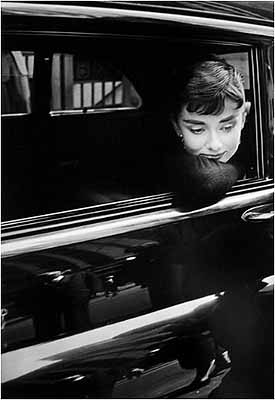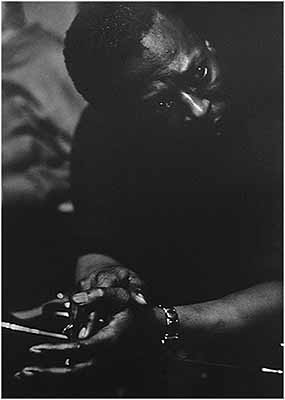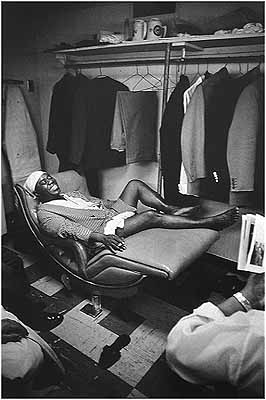
Dennis Stock »
Exhibition: 21 Jan – 1 Mar 2004
HackelBury Fine Art Limited
4 Launceston Place
W8 5RL London
+44 (0)20-79378688
gallery@hackelbury.co.uk
www.hackelbury.co.uk
Tue-Sat 10-17

Dennis Stock seemed born with a capacity to spot the shot that would summarize a situation, and epitomize a person. His childlike receptivity, combined with a refined technical skill and delight in risk-taking, informs the unique composition of his images. Ever prolific – since the 50s Stock has generated a book or an exhibition almost annually – there are nonetheless several images that have become icons of their kind. Most are portraits, of either known or unknown subjects. All are taken in the environment that is an extension of who they are: James Dean hunched against the rain in Times Square, even his cigarette moody in his mouth; Audrey Hepburn on set; the backview of a girl dancing at the Venice Beach Rock Festival, the crowds fanned out in front of her. Born in New York in 1928, Stock’s father died when he was still a young boy, and he left home to join the US Navy aged sixteen. After leaving the Navy he became apprenticed to LIFE Magazine photographer Gjon Mili, who had a reputation for fine graphic sensitivity and a wild desire for experimentation with light and movement. (Later Stock was to dedicate his retrospective volume Made in the USA to Mili, Henri Cartier-Bresson, W Eugene-Smith and Ernst Haas, four pure exponents of ‘humanist’ or ‘ concerned’ photography and rightly credited with being a major influence – not only on Stock but on a generation of photographers). From Mili, too, Stock seems to have learnt the wisdom of attaching his passion for photography to other passions in his life. From 1957-60 he focused on the US jazz scene, producing some astonishing portraits: Louis ‘Satchmo’ Armstrong collapsed with laughter, surrounded by friends and neatly hung suits in his dressing room; Miles Davis among the drifting smoke and empty glasses at Birdland, utterly absorbed by his music; Earl Hines with his band, flinging himself backwards almost off his piano stool, all teeth and keyboard. For 20 years, Stock kept to the tradition of black-and-white reportage, primarily for editorial outlets. He alternated profiles of the charismatically famous with on-the-road projects documenting bikers and Hell's Angels, or domestic series on communal living and alternative lifestyles. Stock had joined the Magnum agency (founded, with others, by at least two of his photographc mentors) in the early 50s. By the end of the 60s he was ready to serve as the first vice-president of its film division. In 1968 he had created a film production company, Visual Obectives Inc., and was increasingly involved in mixing media, using earlier work as stills. By the 70s he was moving into Europe and into colours: by the 80s he could refer to himself as a ‘colour essayist’. It was a period of progression and change. Yet, reflecting on the shift it accompanied – that is, from urban to rural – he acknowledged that ‘moving on has not been easy’. Moving to Provence in the south of France, (the subject of his most lyrical large-scale anthology), he finally returned to his parents’ home continent – his father was Swiss, his mother British – and touched on his father’s medium as a painter in that most painterly of regions. He described his continuing practice of still photography as belonging to the contemplative side of life, essentially at odds with modern societies. (Yet in the last couple of yars he has returned to the USA, living in Connecticut). Conversely, Stock felt that ‘television, with its motion and sound, gives the observer an initial thrill that can rarely be matched by stills’. Indeed, in his 1994 essay ‘Dennis Stock on Dennis Stock’, he expressed ‘high hopes for the potential of the hand-held video camera as the Leica of the future’. His desire to continue in both still and moving media is now harnessed to his concern for environmental protection that has persisted in his documentary journeys from Japan to Alska, Hawaii, and back to his beloved France. He has lectured widely on related themes, and run numerous workshops across Europe and the United States. Yet it is hard for the viewer not to continue to associate him with those seminal portraits and photostories on both the glamorous and the marginal in that most confused and confusing of cultures that was the United States of the 50s through to the 70s: a generation when every kind of change seemed possible, and so many of which were realised.

